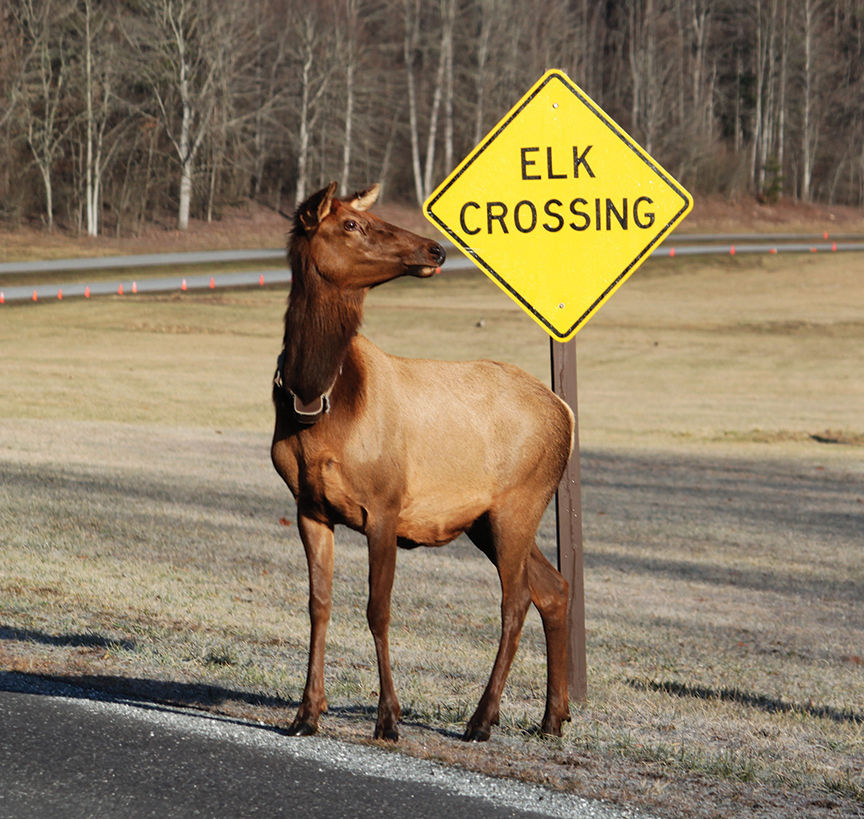Safe Passage Works to Make Interstate 40 Safer for Wildlife and People

Bears stand by a roadside guardrail. Photo by Bridget Donaldson, Virginia Transportation Research Council
Jean Loveday is driving her husband, Tom, home from a doctor’s appointment in Johnson City, Tennessee. Their Toyota pickup truck is winding along Interstate 26, not far from the North Carolina state line north of Asheville.
Suddenly Loveday sees something black tumbling down the mountain and out into the highway in her peripheral view. “Oh no, Tom, oh no!” she mumbles. Loveday realizes it’s a bear cub hurtling toward them. She attempts to avoid hitting it by steering into the median, but vehicle and animal seem destined to collide.
“It all happened so fast,” she says today. “I don’t know where its mother was, whether the cub was following her or on its own. We stopped. It moved for a few minutes, and then was still. All I could think for days was, ‘I killed a bear cub!’ I hope I never, ever have to go through that again.”
Loveday is overwhelmed with emotion as she relates this sad memory, one shared by many motorists in the Southern Appalachians.
“I don’t care where you are on the political spectrum, no one wants to hit an animal with their vehicle,” says Jeff Hunter, senior program manager for National Parks Conservation Association, an organization devoted to protecting and enhancing the national parks system for future generations.
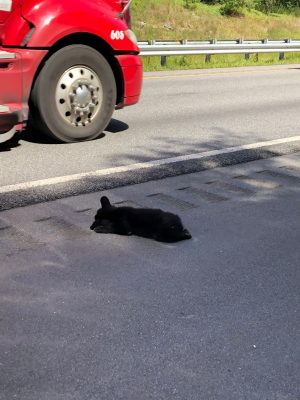
Highways pose lethal hazards to animals looking for food, water and other resources. Photo courtesy of National Parks Conservation Association and Wildlands Network
In early 2017, Hunter convened a group of people who were concerned about the rising numbers of bear, deer and elk being hit on another highway that straddles the Tennessee–North Carolina border—Interstate 40 near Great Smoky Mountains National Park. Some years have seen as many as 70 road-killed bears in this curvy 28-mile section of road alone, and elk reintroduced to the park in 2001 are now crossing the highway to expand their range.
“Human infrastructure is making it increasingly difficult for wildlife to follow their natural patterns of movement across the landscape,” says Hugh Irwin, a landscape conservation planner with The Wilderness Society who raised concerns back in the 1990s about I-40 being a barrier to wildlife movement. “Historically too little thought and planning has gone into wildlife needs, and our current infrastructure fails to provide for wildlife passage.”
Passionate discussions led to action, and soon more than 80 individuals from nearly 20 federal, state, Tribal, and non-governmental organizations were collaborating to make this section of roadway more permeable for wildlife and safer for people. This year, in late February, the group announced itself publicly as Safe Passage: The I-40 Pigeon River Gorge Wildlife Crossing Project.
Roadkill’s “Pernicious Twin”
The intersection of roads and wildlife is a safety issue that is not unique to North Carolina and Tennessee. According to the Federal Highway Administration, an estimated two million large mammals are killed on roads in the United States each year, resulting in more than 26,000 human injuries and at least 200 human fatalities.
For years, road ecologists around the world have been working to mitigate highways that were originally designed without consideration for wildlife. Europe, Canada, Mexico, and many U.S. states have already created effective wildlife road crossings. Recent articles and videos featuring large wildlife overpasses in Utah and Texas have been shared widely on social media.
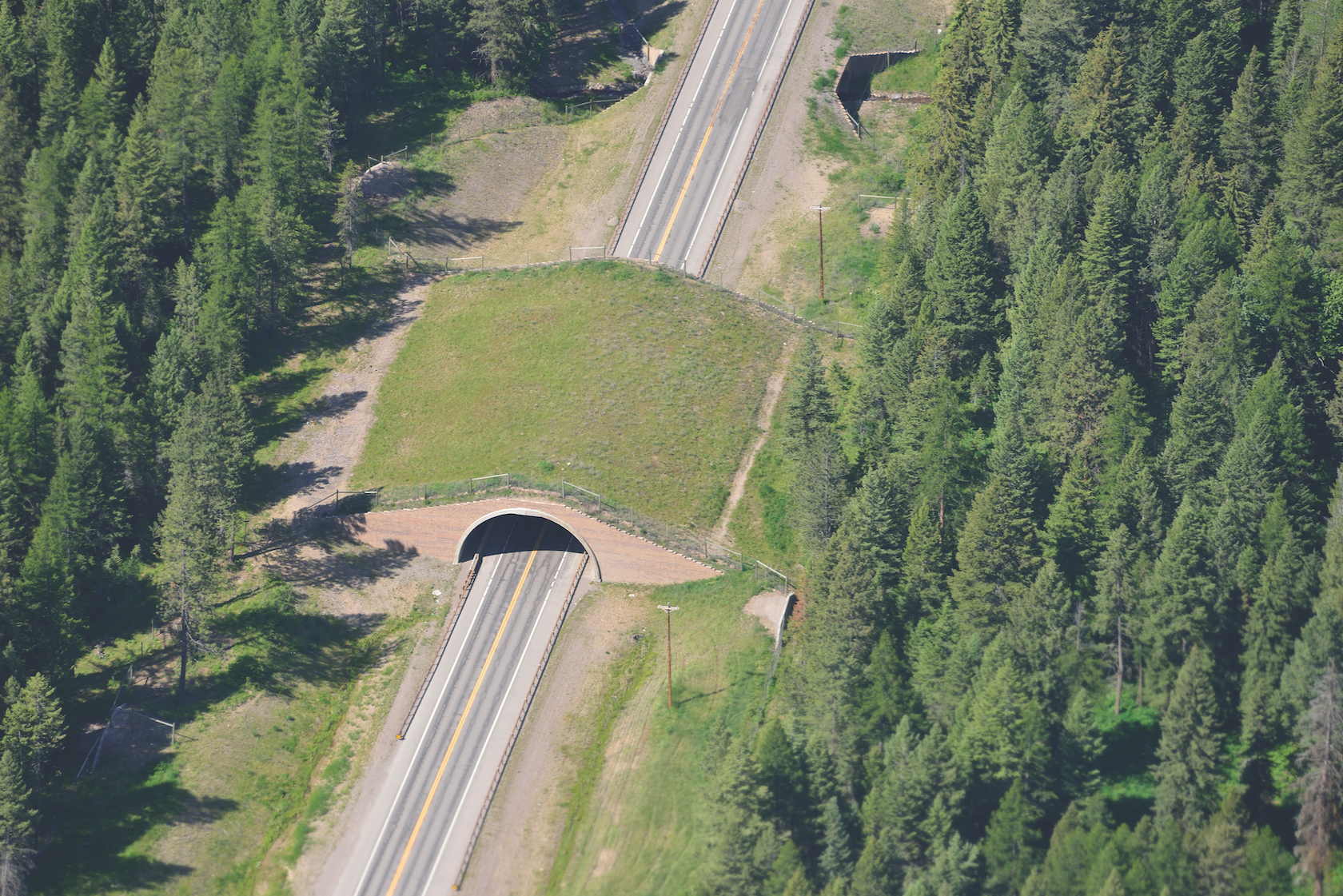
This wildlife overpass and underpass help animals navigate US Hwy 93 on the Flathead Indian Reservation in the state of Montana.
“The solution to addressing issues of wildlife and highway interaction is two-pronged: fencing plus crossing structures,” says Terry McGuire, a highway engineer now retired from Parks Canada and a road ecology expert. “It has been shown through research that one does not work as effectively without the other.” McGuire also points out that one type of crossing does not necessarily meet every animal’s needs and, ideally, a combination of various crossing types—like a buffet of choices—should be provided, spaced out in such a way that animals do not need to travel great distances to find a crossing opportunity.
Photo by Marcel Huijser
Senior Research Ecologist Marcel Huijser (pronounced ‘Houser’) with the Western Transportation Institute at Montana State University in Bozeman has contributed to road ecology studies for more than two decades. He cites three main reasons why people care about this issue: the desire for wildlife conservation, concern for human safety, and economics. “No matter who you are, where you live, or what you do for a living, you’re going to care about at least one of these,” he says.
On November 26, 2019, The Atlantic ran an auspicious road ecology article by Ben Goldfarb titled “How Roadkill Became an Environmental Disaster.” Focusing on the giant anteaters of Brazil, whose range is—you guessed it—bisected by a huge highway, the epic, riveting story introduces readers to Evelyn the anteater and a cast of road-weary researchers. One particular Goldfarb quote became the motto for researchers assessing wildlife movement and mortality in the Pigeon River Gorge: “Collisions may be road ecology’s most obvious concern, but fragmentation is roadkill’s pernicious twin.”
Conservationists point out the gravity of individual animals being killed on roads. But when they no longer try to cross, it can signal an even more dire situation.
“When wildlife finally stops even trying to cross, the highway has become a barrier,” says Hunter. “The ‘barrier effect’ is not to be confused with the concrete Jersey barriers that prevent many individual crossings. When a whole population stops crossing the road, that means their habitat is now fragmented, preventing the healthy genetic exchange that species need to thrive.”
Ron Sutherland works to restore, reconnect and re-establish wildlife corridors that have been fragmented throughout the eastern United States in his role as chief scientist with Wildlands Network, the organization that kicked off discussions about mitigation to I-40 in 2015. He defines habitat connectivity as the degree to which organisms are able to move freely across the landscape.
“Habitat connectivity can be very high, such as in a remote and intact wilderness,” he says, “or it can be very low, such as in a city park surrounded on all sides by busy highways.”
Sutherland points out that people often get wildlife corridors and wildlife road crossings confused.
“A wildlife corridor is the term we use for a defined movement pathway that, if protected or restored, would provide essential habitat connectivity for one or more species,” he says. “They can be easy to see—such as a vegetated trail alongside a roadway—or nearly invisible and defined only by the movements of the animals.”
A wildlife road crossing, on the other hand, is “a structure that is designed to allow wildlife to safely cross over or under a busy road,” he says. “So, of course it follows that one of the best places to put wildlife road crossings is where you have a wildlife corridor that gets cut off by a highway.”
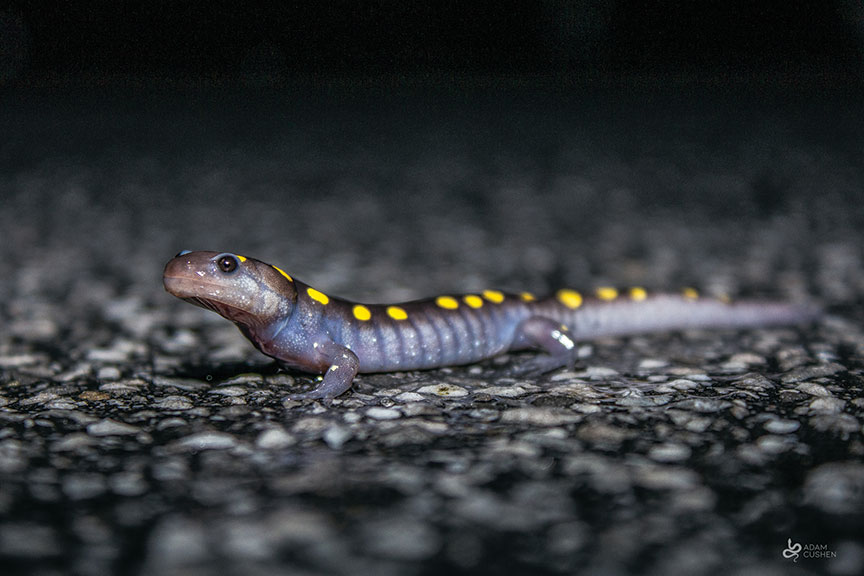
Most wildlife crossings focus on megafauna with little emphasis on smaller species, like this spotted salamander, because of the perception that they do not create a safety threat to vehicles. But, in the grand scheme, as John Muir said, “When we try to pick out anything by itself, we find it hitched to everything else in the universe.” It is ultimately critical for reptiles and amphibians to be able to travel through small pipes under the road surface when larger pieces of landscape under the roadway are not available.
Photo by Adam Cushen
Captivating Research in the Gorge
The best places to put wildlife road crossings along the 28-mile stretch of winding mountainous terrain in the Pigeon River Gorge are precisely what researchers are working to figure out. For the past two years, National Parks Conservation Association and Wildlands Network have been collecting data that will help them identify key areas and strategies for mitigating the road between Asheville and Knoxville, preparing Safe Passage to make recommendations that can be implemented during planned road maintenance and bridge repairs.
Interstate 40 was built in 1968. Like hundreds of roads that now crisscross the Southeast, it sliced through a mountain landscape where animals had freely followed ancient wildlife corridors for millenia. Back in the ’60s, there were fewer vehicles and fewer animals. Today some 27,000 cars and trucks travel this road daily while, not far away, some of the park’s 1,900 black bears are searching for food, mates and shelter, which leads them to traverse the mosaic of wild, steep and rugged public and private lands that make up the gorge.
What’s more, elk too are now attempting to cross these roads, sometimes joining their fellow ungulates, the prolific white-tailed deer, in sad deaths involving hours of suffering.
Researchers are stymied when it comes to finding a way to count the many individual animals who sustain severe injuries and make it off the roadway, only to die later in the forest.
“With both animal and human populations increasing alongside growing tourism in
the Smokies region,” says Hunter, “this situation is expected to get worse over the next decade.”
Wildlife crossings can only succeed if located where animals wish to cross the road, not just where it may be easy or convenient from a construction perspective. To this end, researchers have employed wildlife cameras to help them assess wildlife road mortality patterns in the gorge and examine how some animals use existing structures such as culverts designed to move water under the roads. They have also been tracking wildlife activity in the right-of-way alongside the road. To follow elk movement, wildlife biologist Liz Hilliard is conducting a GPS-collar study.
“The topography is driving where these elk are moving,” says Hilliard, a wildlife biologist with Wildlands Network. “They’re trying to spend the least amount of energy, so they follow low-slope areas, moving through the landscape in what we call the path of least resistance.”
Hillard works closely with Steve Goodman, NPCA’s wildlife researcher in the gorge, whose work is funded by the Volgenau Foundation. He has been servicing the 120 camera traps and collecting their data for the past two years.
“Regionally—and nationally—this area is widely considered to be of high conservation value and comprised of key habitat corridors that are critical for long-term flow of both plants and animals,” Goodman says. “The first step to mitigation is gaining an understanding of how these animals navigate the landscape. Where do they go, when, and why?”
Goodman and Hillard are examining “hotspots” where the most animals are getting killed, as well as places where some fortunate bear, deer and elk are successfully getting from one side of the interstate to the other. Their data will prepare Safe Passage to collaborate with local departments of transportation on bridge improvements planned for the next five years. The first of these may begin as early as fall of 2021 at the Harmon Den exit near the intersection with the Appalachian Trail, where a herd of elk have dispersed from the population reintroduced in the Smokies 20 years ago.
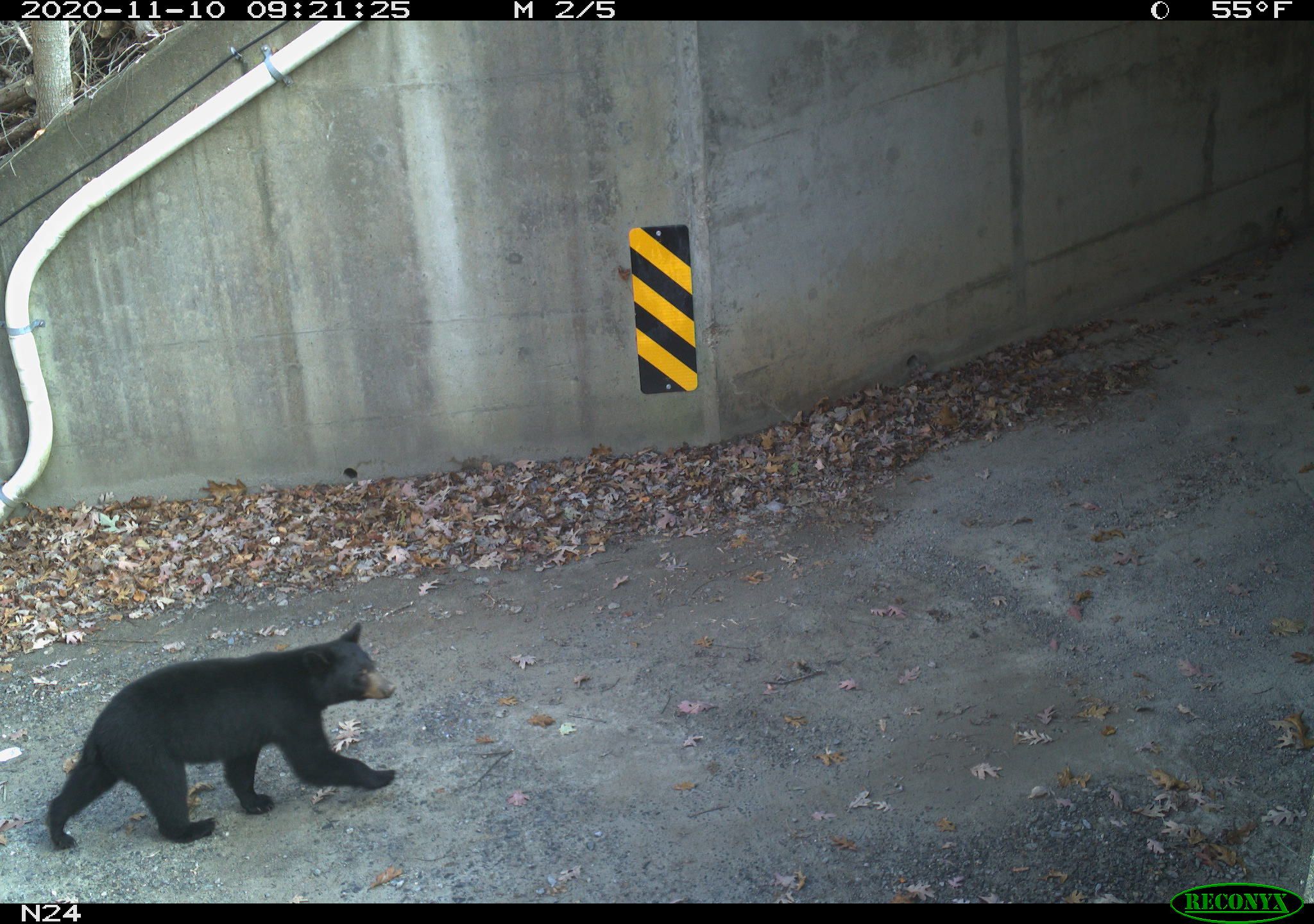
A recent study determined that more than 90% of male black bears and 50% of female black bears regularly travel out of Great Smoky Mountains National Park to access other habitats. This inevitably means they have to cross regional highways as well as secondary roads.
Photo courtesy of National Parks Conservation Association and Wildlands Network
Benefits Outweigh the Costs
When it comes to road ecology, the economic reality can be as shocking as the roadkill. But Huijser says, in the long term, the benefits outweigh the costs.
“Collision-related costs add up to roughly $12 billion annually in the U.S.,” he says. “The cost of a deer–vehicle collision averages around $6,000 and running into an elk can cost upwards of $17,000.”
Wildlife crossing structures and road mitigation have improved human safety and wildlife corridor connectivity at Snoqualmie Pass on I-90 in Washington State, along the Trans-Canada Highway in the Rocky Mountains and Banff National Park, and on the Flathead Indian Reservation in Western Montana where Huijser worked for 13 years. In these examples, fencing successfully reduces collisions and guides wildlife to safe-crossing opportunities such as vegetated overpasses, open-span bridges, and large- and medium-mammal underpasses. Dozens of such wildlife corridor projects have led to an 80–95 percent collision reduction with large mammals like deer and elk since the mid-’90s.
Although road mitigation measures are good for human safety and for animals, they cost money. Fences may cost about $100,000 per mile, an underpass may require around half a million to build, and a single wildlife overpass can cost up to $10 million.
But Huijser the research ecologist says that society can’t afford not to.
“Implementing effective mitigation measures substantially reduces costs associated with wildlife–vehicle collisions by 80–100 percent,” Huijser says. “Bottom line: Even if people don’t care about human safety or wildlife conservation, it can still make economic sense. And if you consider the biological conservation aspect, the value expands to take in benefits to local tourism economies and other economic benefits of having healthy wildlife populations in the landscape.”
In 2020 and 2021, Wildlands Network worked with a coalition of Virginia partners to get landmark bipartisan legislation passed in support of wildlife crossings. These efforts direct the relevant agencies to collaborate, incorporating wildlife corridors and road crossings into their design and planning stages—a major step forward both in protecting motorists from collisions with animals and in addressing barriers to wildlife movement.

Bobcats, coyotes, foxes, raccoons, and many other small species already use several existing culverts. This bobcat was photographed using a culvert to pass beneath I-40. Photo courtesy of National Parks Conservation Association and Wildlands Network.
“Here in North Carolina, our coalition is analyzing an array of possible mechanisms that will best serve the agencies and goals of connectivity on the landscape to achieve significant reduction of collisions with wildlife,” says Christine Laporte, the Eastern program director at Wildlands Network. “Safety, conservation, economic considerations of crossing, and mitigation initiatives all benefit from a range of state-level mechanisms that support use of the best available science for effective designs and actual structures on the ground.”
Irwin of The Wilderness Society says, “Going forward, wildlife movement patterns and needs should be incorporated into infrastructure planning, and existing infrastructure should be retrofitted over time to enable better wildlife movement without the current high levels of wildlife mortality as well as human impacts and property damage.”
Whatever road mitigations and crossing structures are eventually implemented in the steep terrain of the Pigeon River Gorge, Safe Passage hopes its collaborative effort will become the model for others championing change on regional roads with similar issues. For example, elk often congregate near and on Highway 19 in Maggie Valley and Cherokee, North Carolina. In October of 2019, an elk was found dead on the shoulder of Interstate 26 in East Tennessee approaching Sams Gap, not far from the Appalachian Trail. This death alerted researchers to the fact that these large ungulates are beginning to cross rivers and disperse to create new herds far from their 2001 reintroduction site in Cataloochee on the southeastern side of the Smokies.
“Our research in the Pigeon River Gorge is now in its final stages,” says Hunter, “and we don’t have all the answers yet. But one thing we do know is that collaborative partnerships like Safe Passage are critical to finding the best path forward.”
The Safe Passage Fund Coalition comprises The Conservation Fund, Defenders of Wildlife, Great Smoky Mountains Association, National Park Conservation Association, North Carolina Wildlife Federation, and Wildlands Network. Visit smokiessafepassage.org to learn more about the project or make a donation to fund wildlife-crossing structures and fencing.
Frances Figart is the Creative Services Director for Great Smoky Mountains Association, an educational nonprofit partner of Great Smoky Mountains National Park. Reach her at frances[at]gsmassoc.org.
This 17-second clip captured by Susan Winter Detwiler on August 19, 2018, went viral on Facebook and beyond. It demonstrates both the conservation issue and the human safely hazards, showing the need for wildlife-crossing structures in this perilous section of highway.
Related Articles
Latest News

Leave a comment
Your email address will not be published. Required fields are marked *


